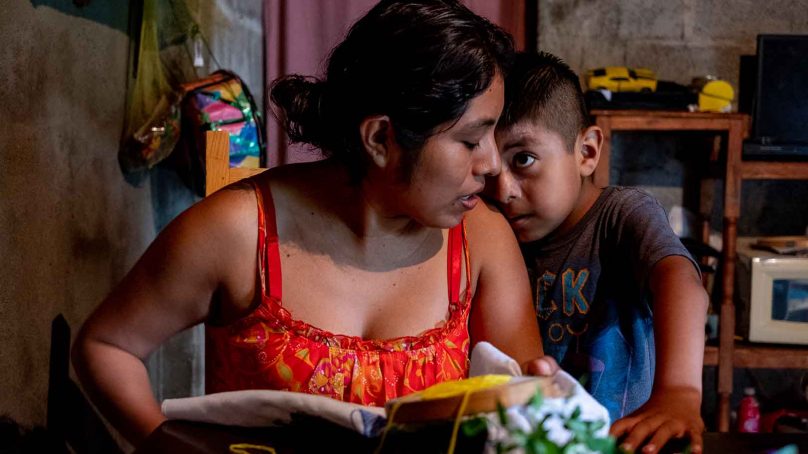
Most of the time, to write about migration means telling the stories of people who move: those forced from their homes by natural disasters, conflict, violence or the effects of climate change, or so fed up with limited economic opportunities, corruption and bad governance that the faint glint of possibility on the horizon is enough to pull them away.
Movement is dramatic, so it attracts attention. But there is a flipside to the story of migration that is often overlooked: For almost every person who moves, there are others who remain behind. Often, these people are women whose mobility is limited by social norms and narrowly defined gender roles.
Over the past six years, we have interviewed more than 60 women in India, Mexico, Ethiopia and Senegal whose lives have been directly and significantly shaped by migration, even though they were not on-the-move. The project we created – Women Who Stay – aims to tell their stories and present a more complete picture of what migration means. Here is what we’ve learned:
When men migrate, their families frequently end up better off financially compared to others in the same community. But remittances from abroad don’t necessarily cover all of a family’s needs, and they are often divided among multiple family members.
As a result, women who remain behind frequently find it necessary to earn money. This can come as a burden on top of their existing domestic workload, but it can also gain them a degree of economic independence they otherwise may not have had.
In 2018, for example, we met Magat in Ndiébène Gandiole, a coastal village in northern Senegal. Magat, a Wolof woman in her thirties, was married to Diop, a fisherman. Like many others, he struggled to make a living as fishing vessels from China, Russia and the European Union increasingly plied Senegalese waters.
Magat’s husband migrated from Senegal to Spain to find better work and she took on additional jobs. She cares for the animals and, she said, “every morning, after I clean and cook, I go to my [food] shop by the road. I open it at seven o’clock.”
In 2006, Diop left for Spain, where he worked as a fisherman, sending remittances home. Magat, meanwhile, shouldered the responsibilities of motherhood while also working to earn more money.
As we spoke one morning, Magat led her four-year-old daughter, Jasin, to a cage of turkeys in their yard. In addition to taking care of the animals, “every morning, after I clean and cook, I go to my [food] shop by the road. I open it at seven o’clock,” Magat said. “If there are any celebrations in our village, I also go to braid women’s hair.”
Despite the challenges, having two incomes has given the family a degree of financial stability: When we met Magat, she was overseeing the construction of their new home.
For people who cannot get visas, crossing borders irregularly often involves employing smugglers who charge hundreds or thousands of dollars for their services. Many families cannot afford these fees up front and have to go into debt to send someone abroad.
In the long-term, families are hoping the economic benefits of migration will be worth it. But in the short-term, women often have to work to support their children and relatives while the debt is being paid off.
This was the case for Raquel Cruz, whom we met in 2017 in the humid, hilly region of La Huasteca in Mexico’s San Luis Potosí state. Her husband, Leo, was in the United States. He had migrated and returned multiple times. “Leo is still paying off the loan that we got from the bank when he decided to go back to the US,” Raquel said.
Raquel cooked meals for teachers at a local school and collected honey to sell with the help of a local NGO.
Medium shot of a mother and a son. The mother is holding a book on her lap her face is turned to her left shoulder where her son rests his cheek as he looks up to her. Noel Rojo
Crossing borders irregularly is often costly. Raquel said from Mexico in 2017 that her husband, Leo, “is still paying off the loan that we got from the bank when he decided to go back to the US.” She took on more work to help pay the loan.
Flor Mateo, from San Marcos Tlapazola in Oaxaca, Mexico, also found herself having to work, but for different reasons: Her husband abandoned her and their daughter after he migrated to the United States. “If I did not want to be a burden for my parents, I had to start working, and my daughter went to childcare,” Flor said when we met her in 2017.
Flor’s husband had been abusive, she said. So, his leaving came as a relief. “He was aggressive. He was beating me… even when I was pregnant and after our daughter was born. But we stayed together, since we thought that it would be best for her,” Flor said. “The moment when he decided to go to the US was the best thing that could happen to me.”
Other women who are abandoned or whose husbands or sons are among the thousands of people who die or disappear every year while migrating often struggle psychologically and have a hard time coming to terms with the loss.
“I would rather die than continue living like this,” said Mama Lethay Kahsai, a woman in her fifties whom we met in the village of Dega in the Tigray region of Ethiopia in 2018, before the war broke out. Her son died after migrating to Saudi Arabia – a popular destination for Ethiopians. Mama Lethay found out from a neighbour, and she is now completely dependent on support from the community and NGOs.
- The New Humanitarian report / By Magdalena and Noel Rojo











